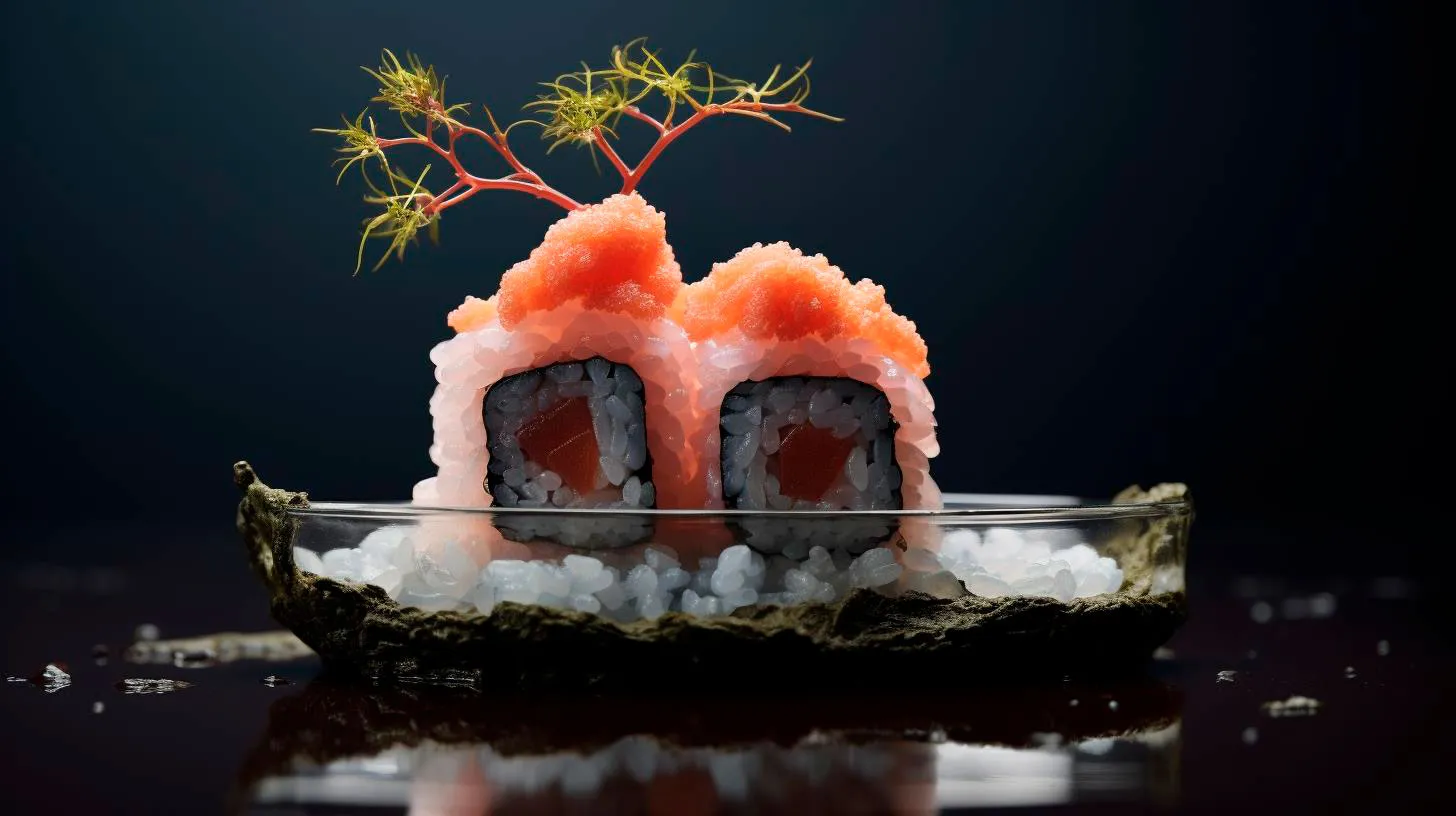Exploring American Sushi: A Unique Culinary Blend of Traditions
In this article, we will delve into the fascinating world of American sushi, exploring its origins, key characteristics, and how it has evolved to become a beloved culinary gem.
The Origins of American Sushi
Sushi made its debut in the United States in the late 1800s when Japanese immigrants began settling in cities like San Francisco and Los Angeles. Initially, traditional forms of sushi, like nigiri and maki, were introduced to satisfy the culinary cravings of the immigrant population. However, as the popularity of sushi grew among Americans, chefs started experimenting with local ingredients, leading to the birth of American sushi.
American sushi retains the fundamental techniques of Japanese sushi-making but adds a touch of innovation by incorporating flavors and ingredients that resonate with the American palate. This fusion of traditions has given rise to creative sushi rolls, exciting topping combinations, and unique dipping sauces that make American sushi a truly distinctive culinary experience.
Characteristics of American Sushi
When it comes to American sushi, several characteristics set it apart from its Japanese counterpart. Let’s explore some of the defining features:
1. Creative Sushi Rolls
American sushi is synonymous with creative and elaborate sushi rolls. Unlike traditional Japanese sushi, which primarily focuses on simplicity and showcasing the freshness of the ingredients, American sushi embraces a more playful approach. Sushi rolls often come adorned with various toppings, ranging from crispy tempura flakes to tangy mayonnaise-based sauces. This combination of textures and flavors adds an exciting element to each bite, keeping diners coming back for more.
2. Fusion of Flavors
Incorporating American ingredients and flavors into sushi has been a game-changer. American sushi rolls often feature ingredients like avocado, cream cheese, spicy mayo, and even barbecue sauce. These flavor combinations offer a unique twist and cater to the diverse taste preferences of American diners. The fusion of traditional Japanese techniques with American flavors creates a harmonious blend that is both comforting and adventurous.
3. Emphasis on Variety
American sushi menus boast a wide array of options to cater to every palate. From vegetarian sushi rolls packed with fresh vegetables to indulgent rolls filled with tempura shrimp and spicy tuna, there is something for everyone. This emphasis on variety ensures that diners can explore different flavor profiles and find their personal favorites.
The Evolution of American Sushi
Over the years, American sushi has continued to evolve, adapting to changing culinary trends and consumer demands. The fusion of different cuisines with sushi has become increasingly popular, introducing new and exciting dishes to the sushi scene. Here are some notable aspects of American sushi’s evolution:
1. Sushi Burritos
American sushi has taken inspiration from Mexican cuisine and introduced sushi burritos, which are essentially oversized sushi rolls wrapped in seaweed. These burritos offer a convenient way to enjoy sushi on the go and are packed with a variety of fillings, such as sushi-grade fish, vegetables, and rice, all rolled into one scrumptious handheld delight.
2. Sushi Bowls
An innovative spin on traditional sushi, sushi bowls have gained popularity among health-conscious diners. These bowls typically consist of a bed of sushi rice topped with fresh fish or vegetables, along with an assortment of garnishes and sauces. Sushi bowls offer a customizable experience, allowing diners to mix and match their favorite ingredients.
3. Sustainable Sourcing
As sustainability becomes a growing concern, many American sushi restaurants have started prioritizing responsibly sourced fish and seafood. This trend ensures that diners can enjoy their sushi guilt-free, knowing that the ingredients have been sourced with consideration for our oceans and their delicate ecosystems.
Key Takeaways
- American sushi blends Japanese techniques with American ingredients and flavors, resulting in a unique and vibrant culinary experience.
- Creative sushi rolls, fusion of flavors, and an emphasis on variety are key characteristics of American sushi.
- American sushi has evolved to include dishes like sushi burritos and sushi bowls, catering to changing food trends and consumer preferences.
- Sustainable sourcing of fish and seafood is becoming increasingly important in the American sushi industry.
As American sushi continues to evolve and captivate the taste buds of food enthusiasts, it remains a testament to the power of culinary fusion and adaptation. Whether you’re a sushi aficionado or new to the world of sushi, exploring the flavors and artistry of American sushi is a must-try experience.
The American Sushi Revolution: A Delicious Fusion of East and West
The American Sushi Revolution is not just about adding a twist to traditional sushi rolls; it represents a cultural shift and a celebration of culinary diversity. It blends Japanese techniques with American flavors, creating a unique culinary experience that appeals to a wide range of food enthusiasts.
The Rise of American Sushi
As global travel and cultural exchange have become more accessible, Americans have developed a growing appreciation for international cuisines. Sushi, with its artful presentation and healthy ingredients, has captured the imagination of many. The rise in popularity of sushi has prompted American chefs to experiment and put their own spin on this beloved dish.
Several factors have contributed to the American Sushi Revolution:
- Localization: American chefs have adapted traditional sushi ingredients to cater to local tastes. They have incorporated ingredients such as cream cheese, avocado, and even fried chicken into sushi rolls, creating an exciting fusion of flavors.
- Creative Presentation: Americans love visually appealing dishes, and sushi chefs have taken advantage of this by creating vibrant and artistic sushi rolls. From sushi burritos to sushi bowls, the possibilities are endless.
- Health Consciousness: Sushi is known for its healthy qualities, as it often includes fresh fish, vegetables, and whole grains. As health consciousness has grown among Americans, sushi has become an attractive option for those seeking a nutritious meal.
- Foodie Culture: The rise of foodie culture in America has led to a greater appreciation for culinary experimentation. People are willing to try new and unconventional dishes, making sushi an ideal candidate for innovation.
The Delightful Sushi Creations
The American Sushi Revolution has given birth to a plethora of mouth-watering creations. Here are a few notable examples:
1. The California Roll
The California Roll is often credited as the start of the American Sushi Revolution. Invented in Los Angeles in the 1960s, it replaced raw fish with avocado, making sushi more accessible to those hesitant about trying raw seafood. With its combination of creamy avocado, cucumber, and imitation crab, the California Roll quickly gained popularity and spread throughout the country.
2. The Spicy Tuna Roll
The Spicy Tuna Roll is another beloved creation of the American Sushi Revolution. It consists of fresh tuna mixed with spicy mayo, wrapped in rice and seaweed. The kick of spiciness added to the roll has become a favorite among sushi enthusiasts, giving a bold twist to the traditional flavors.
3. The Sushi Burrito
Combining the convenience of a burrito with the flavors of sushi, the Sushi Burrito has gained a cult following in recent years. It consists of a large sushi roll wrapped in a seaweed sheet, resembling a burrito. With a variety of ingredients and sauces, the Sushi Burrito offers endless possibilities for customization.
4. The Tempura Roll
The Tempura Roll takes the traditional sushi roll to a new level by adding a crunchy twist. Tempura-battered and deep-fried vegetables or seafood are combined with sushi rice and wrapped in seaweed. The result is a delectable combination of textures – crispy on the outside and tender on the inside.
The Key Takeaways
The American Sushi Revolution has transformed the sushi landscape in America, offering a delightful fusion of East and West. Here are the key takeaways from this culinary revolution:
- The American Sushi Revolution blends Japanese techniques with American flavors.
- Localization and creative presentation have played a significant role in the popularity of American sushi.
- The fusion of flavors and ingredients has resulted in mouth-watering creations like the California Roll, Spicy Tuna Roll, Sushi Burrito, and Tempura Roll.
- Sushi has become a healthier and more accessible option for health-conscious individuals.
- The American Sushi Revolution is a testament to the evolving tastes and culinary diversity in America.
Next time you visit a sushi restaurant, don’t be surprised to find a menu filled with exciting American sushi creations that pay homage to the traditional art of Japanese sushi. Embrace the American Sushi Revolution and indulge in the fusion of flavors that celebrate the best of both worlds.
The Evolution of Sushi in America: From Niche Cuisine to Mainstream Sensation
In this article, we will explore the evolution of sushi in America, from its humble beginnings to its current widespread popularity.
1. Introduction of Sushi to America
The first sushi restaurant in the United States, called Kawafuku, opened its doors in Los Angeles in 1966. Initially, sushi faced significant skepticism and resistance from Americans who were unfamiliar with raw fish and the unique flavors of Japanese cuisine. However, as more Japanese immigrants settled in the country and their culinary traditions gained recognition, sushi slowly started to gain traction.
2. Sushi Goes Mainstream
The turning point for sushi’s popularity came in the 1980s and 1990s when the concept of fusion cuisine began to emerge. Chefs started incorporating Western ingredients and flavors into traditional sushi, catering to American tastes. This innovative approach appealed to a broader audience, and sushi began to appear on menus outside of Japanese restaurants.
Another significant factor contributing to sushi’s mainstream success was the rise of health consciousness in America. Sushi’s reputation as a nutritious and low-calorie option attracted health-conscious individuals, further driving its popularity.
3. The Sushi Boom
In the early 2000s, the sushi industry experienced a significant boom. Sushi bars and restaurants began popping up in every major city, offering a wide range of sushi options at various price points. The media played a crucial role in promoting sushi as a trendy and sophisticated dining choice, further fueling its popularity among young urban professionals.
Additionally, advancements in transportation and refrigeration technology made it easier for restaurants to source high-quality fish and maintain its freshness, ensuring a consistent supply of sushi throughout the country.
4. Sushi Trends and Adaptations
As sushi gained popularity, it continued to evolve to suit the American palate and culinary preferences. Some notable trends and adaptations include:
- Sushi rolls: The introduction of the California roll, with avocado, imitation crab, and cucumber, marked a breakthrough in sushi’s acceptance among those who were hesitant about raw fish.
- Fusion sushi: Chefs began experimenting with ingredients and flavors, creating fusion sushi rolls that combined traditional Japanese elements with influences from other cuisines.
- Vegetarian and vegan options: To cater to dietary preferences and restrictions, sushi menus expanded to include a variety of vegetarian and vegan options, utilizing ingredients like tofu, mushrooms, and seaweed.
5. Sushi’s Status Today
Today, sushi has firmly established itself as a mainstream cuisine in America. American sushi chefs have gained recognition for their skill and creativity, pushing the boundaries of traditional sushi. The sushi industry’s revenue in the United States reached an estimated $2.5 billion in 2020, according to Statista.
Japanese sushi chains have also expanded their presence in America, providing authentic dining experiences and further contributing to sushi’s popularity. Moreover, the availability of pre-packaged sushi in grocery stores and the increasing use of sushi delivery services have made it even more accessible to consumers.
Key Takeaways
- Sushi has come a long way in America, transforming from a niche cuisine to a mainstream sensation.
- The introduction of fusion sushi and heightened health consciousness played significant roles in sushi’s popularity.
- Advancements in transportation and refrigeration technology ensured a consistent supply of high-quality fish.
- Sushi has adapted to American tastes through the introduction of sushi rolls, fusion sushi, and vegetarian/vegan options.
- Sushi’s popularity continues to grow, with the industry generating billions of dollars in revenue each year.
In conclusion, the evolution of sushi in America represents a fascinating journey from niche cuisine to mainstream sensation. Sushi’s ability to adapt to American tastes while preserving its core elements has been the key to its widespread success. Whether enjoyed at a high-end restaurant or grabbed as a quick lunch from a grocery store, sushi has undoubtedly become an integral part of American culinary culture.
American vs Japanese Sushi: Discovering the Key Differences
In this article, we will explore the key differences between American and Japanese sushi, highlighting their unique features, advantages, and key takeaways.
American Sushi Experience
American sushi, often referred to as “Western-style sushi,” has evolved over time to cater to local tastes and preferences. While it still incorporates some elements of traditional Japanese sushi, it also incorporates distinctly American flavors and ingredients.
Key Features of American Sushi:
- Wide variety: American sushi offers an extensive range of options with diverse fillings, including cooked seafood, vegetables, and even meat.
- Creative rolls: American chefs have taken sushi rolling to another level by introducing innovative rolls like the California roll, with ingredients such as avocado, cucumber, and imitation crab. These rolls are often bigger and more substantial.
- Spicy sauces: American sushi frequently features spicy sauces like sriracha mayo or spicy mayonnaise, adding an extra kick to the flavor profile.
- Deep-fried options: American sushi incorporates deep-frying techniques, resulting in crispy tempura rolls that provide a unique texture and flavor.
American sushi emphasizes variety and experimentation, catering to a broader audience with different palates. The fusion of diverse ingredients and flavors has made it a hit among those who prefer bold and unique taste experiences.
Japanese Sushi Tradition
Japanese sushi, the original form of this delicacy, is steeped in tradition and represents an art form. It exemplifies simplicity, precision, and the use of high-quality ingredients.
Key Features of Japanese Sushi:
- Focus on freshness: Japanese sushi emphasizes the use of fresh, raw fish and seafood, enhancing the natural flavors of the ingredients. It places a premium on the quality and sourcing of the fish.
- Minimalist approach: The simplicity of Japanese sushi is evident in the minimal use of condiments, allowing the focus to remain on the quality of the fish and rice. Authentic Japanese sushi rarely includes excessive sauces or deep-fried elements.
- Traditional nigiri: Nigiri sushi, consisting of a slice of raw fish or seafood atop a small oblong-shaped mound of vinegared rice, is a staple in Japanese sushi culture. The chef’s skills in crafting the perfect balance of flavors and textures are on full display with this classic preparation.
- Omakase experience: The concept of “omakase,” meaning “I leave it up to you,” allows the sushi chef to create a personalized tasting experience for the diner. It showcases the chef’s expertise and knowledge of seasonal ingredients.
Japanese sushi emphasizes the harmony of flavors, textures, and presentation. It is an artful experience that focuses on the appreciation of the ingredients and the craftsmanship of the sushi chef.
American vs Japanese Sushi: Key Takeaways
Understanding the differences between American and Japanese sushi can help diners choose the experience that aligns best with their preferences and expectations. Here are some key takeaways to consider:
- American sushi offers a wide variety of flavors, inventive rolls, and fusion options that cater to diverse tastes.
- Japanese sushi focuses on the purity of ingredients, fresh flavors, and the skilled craftsmanship of the sushi chef.
- American sushi leans toward experimentation and creativity, while Japanese sushi emphasizes tradition and simplicity.
- Both American and Japanese sushi styles have their own unique appeal, offering distinct experiences for sushi enthusiasts.
Whether you’re seeking bold and unconventional flavors or a traditional, refined sushi experience, both American and Japanese sushi have something exceptional to offer. Exploring these diverse styles can open your taste buds to a world of exquisite flavors and culinary artistry.


